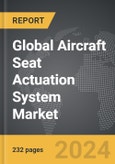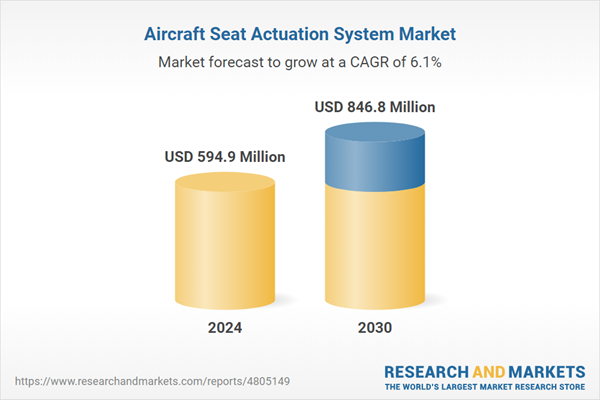The global market for Aircraft Seat Actuation System was valued at US$594.9 Million in 2024 and is projected to reach US$846.8 Million by 2030, growing at a CAGR of 6.1% from 2024 to 2030. This comprehensive report provides an in-depth analysis of market trends, drivers, and forecasts, helping you make informed business decisions. The report includes the most recent global tariff developments and how they impact the Aircraft Seat Actuation System market.
Segments: Type (Electromechanical, Pneumatic, Hydraulic); Seat Class (Business, Premium Economy, First, Economy); Aircraft Type (Fixed Wing, Rotary Wing).
Geographic Regions/Countries: World; United States; Canada; Japan; China; Europe (France; Germany; Italy; United Kingdom; Spain; Russia; and Rest of Europe); Asia-Pacific (Australia; India; South Korea; and Rest of Asia-Pacific); Latin America (Argentina; Brazil; Mexico; and Rest of Latin America); Middle East (Iran; Israel; Saudi Arabia; United Arab Emirates; and Rest of Middle East); and Africa.
The analysts continuously track trade developments worldwide, drawing insights from leading global economists and over 200 industry and policy institutions, including think tanks, trade organizations, and national economic advisory bodies. This intelligence is integrated into forecasting models to provide timely, data-driven analysis of emerging risks and opportunities.
Global Aircraft Seat Actuation System Market - Key Trends and Drivers Summarized
What is an Aircraft Seat Actuation System?
An aircraft seat actuation system is an advanced technological solution designed to control the movement and adjustment of airplane seats. These systems are pivotal in enhancing passenger comfort, enabling a range of motions such as reclining, sliding, and adjusting the lumbar support. Typically, these systems include a combination of mechanical components, electronic controls, and software algorithms that work in unison to provide smooth and precise seat adjustments. Modern aircraft seat actuation systems are integral to both commercial and business aircraft, offering personalized seating arrangements that can be adjusted with the touch of a button, often integrated into the seat’s armrest or accessible via a personal screen interface. The complexity and reliability of these systems underscore their importance in the aviation industry, where passenger comfort and safety are paramount.How Do These Systems Work and What Technologies Are Involved?
Aircraft seat actuation systems employ a blend of electromechanical technology, sensors, and control units to deliver precise seat movements. At the heart of these systems are linear actuators, which convert electrical energy into mechanical motion, enabling the seat to move in various directions. These actuators are often powered by lightweight and compact electric motors designed to fit within the limited space of an aircraft seat structure. Additionally, the integration of advanced sensors allows for real-time feedback and control, ensuring that movements are smooth and responsive to passenger inputs. The software that governs these systems plays a crucial role, utilizing algorithms to manage power consumption, optimize performance, and provide a seamless user experience. Innovations such as brushless motors, smart actuators, and energy-efficient power management systems are continually enhancing the functionality and efficiency of seat actuation systems.What Are the Current Trends in Aircraft Seat Actuation Systems?
The aviation industry is witnessing significant advancements in aircraft seat actuation systems, driven by the demand for enhanced passenger comfort and the need for more efficient and reliable systems. One notable trend is the move towards lighter and more compact components, which help reduce the overall weight of the aircraft, contributing to fuel efficiency and lower operating costs. Additionally, there is a growing emphasis on integrating smart technologies, such as Internet of Things (IoT) connectivity, which allows for real-time monitoring and diagnostics of seat actuation systems, ensuring they operate optimally and can be serviced proactively. Furthermore, the adoption of modular designs is making it easier to customize and upgrade seating configurations, catering to the diverse needs of different airlines and passenger segments. Enhanced ergonomics, user-friendly interfaces, and increased automation are also shaping the future of aircraft seat actuation systems, making them more intuitive and responsive to passenger needs.What Drives the Growth in the Aircraft Seat Actuation Systems Market?
The growth in the aircraft seat actuation systems market is driven by several factors. Firstly, the increasing demand for air travel, particularly in emerging economies, is leading to a surge in new aircraft orders, thereby boosting the need for advanced seating solutions. Secondly, airlines are investing heavily in upgrading their fleets to improve passenger comfort and differentiate themselves in a highly competitive market. This includes the installation of state-of-the-art seat actuation systems that offer superior comfort and convenience. Thirdly, technological advancements are playing a critical role, with innovations such as lightweight materials, energy-efficient actuators, and smart control systems driving the adoption of these solutions. Additionally, the rising consumer expectations for personalized and luxurious travel experiences are compelling airlines to invest in premium seating options equipped with the latest actuation technologies. Lastly, regulatory standards and safety requirements are becoming more stringent, necessitating the adoption of reliable and high-performance seat actuation systems to comply with international aviation standards. These factors collectively contribute to the robust growth and dynamic evolution of the aircraft seat actuation systems market.Report Scope
The report analyzes the Aircraft Seat Actuation System market, presented in terms of units. The analysis covers the key segments and geographic regions outlined below.Segments: Type (Electromechanical, Pneumatic, Hydraulic); Seat Class (Business, Premium Economy, First, Economy); Aircraft Type (Fixed Wing, Rotary Wing).
Geographic Regions/Countries: World; United States; Canada; Japan; China; Europe (France; Germany; Italy; United Kingdom; Spain; Russia; and Rest of Europe); Asia-Pacific (Australia; India; South Korea; and Rest of Asia-Pacific); Latin America (Argentina; Brazil; Mexico; and Rest of Latin America); Middle East (Iran; Israel; Saudi Arabia; United Arab Emirates; and Rest of Middle East); and Africa.
Key Insights:
- Market Growth: Understand the significant growth trajectory of the Electromechanical System segment, which is expected to reach US$727.0 Million by 2030 with a CAGR of a 6.2%. The Pneumatic System segment is also set to grow at 5.2% CAGR over the analysis period.
- Regional Analysis: Gain insights into the U.S. market, valued at $157.9 Million in 2024, and China, forecasted to grow at an impressive 9.9% CAGR to reach $190.7 Million by 2030. Discover growth trends in other key regions, including Japan, Canada, Germany, and the Asia-Pacific.
Why You Should Buy This Report:
- Detailed Market Analysis: Access a thorough analysis of the Global Aircraft Seat Actuation System Market, covering all major geographic regions and market segments.
- Competitive Insights: Get an overview of the competitive landscape, including the market presence of major players across different geographies.
- Future Trends and Drivers: Understand the key trends and drivers shaping the future of the Global Aircraft Seat Actuation System Market.
- Actionable Insights: Benefit from actionable insights that can help you identify new revenue opportunities and make strategic business decisions.
Key Questions Answered:
- How is the Global Aircraft Seat Actuation System Market expected to evolve by 2030?
- What are the main drivers and restraints affecting the market?
- Which market segments will grow the most over the forecast period?
- How will market shares for different regions and segments change by 2030?
- Who are the leading players in the market, and what are their prospects?
Report Features:
- Comprehensive Market Data: Independent analysis of annual sales and market forecasts in US$ Million from 2024 to 2030.
- In-Depth Regional Analysis: Detailed insights into key markets, including the U.S., China, Japan, Canada, Europe, Asia-Pacific, Latin America, Middle East, and Africa.
- Company Profiles: Coverage of players such as Almec EAS Ltd., Astronics Corporation, Buhler Motor GmbH, Crane & Company, ITT Corporation and more.
- Complimentary Updates: Receive free report updates for one year to keep you informed of the latest market developments.
Some of the 13 companies featured in this Aircraft Seat Actuation System market report include:
- Almec EAS Ltd.
- Astronics Corporation
- Buhler Motor GmbH
- Crane & Company
- ITT Corporation
- Kyntronics
- Nook Industries, Inc.
- Rollon India Pvt. Ltd.
- Zodiac Aerospace SA
Tariff Impact Analysis: Key Insights for 2025
Global tariff negotiations across 180+ countries are reshaping supply chains, costs, and competitiveness. This report reflects the latest developments as of April 2025 and incorporates forward-looking insights into the market outlook.The analysts continuously track trade developments worldwide, drawing insights from leading global economists and over 200 industry and policy institutions, including think tanks, trade organizations, and national economic advisory bodies. This intelligence is integrated into forecasting models to provide timely, data-driven analysis of emerging risks and opportunities.
What’s Included in This Edition:
- Tariff-adjusted market forecasts by region and segment
- Analysis of cost and supply chain implications by sourcing and trade exposure
- Strategic insights into geographic shifts
Buyers receive a free July 2025 update with:
- Finalized tariff impacts and new trade agreement effects
- Updated projections reflecting global sourcing and cost shifts
- Expanded country-specific coverage across the industry
Table of Contents
I. METHODOLOGYII. EXECUTIVE SUMMARY2. FOCUS ON SELECT PLAYERSIII. MARKET ANALYSISCANADAITALYSPAINRUSSIAREST OF EUROPESOUTH KOREAREST OF ASIA-PACIFICARGENTINABRAZILMEXICOREST OF LATIN AMERICAIRANISRAELSAUDI ARABIAUNITED ARAB EMIRATESREST OF MIDDLE EASTIV. COMPETITION
1. MARKET OVERVIEW
3. MARKET TRENDS & DRIVERS
4. GLOBAL MARKET PERSPECTIVE
UNITED STATES
JAPAN
CHINA
EUROPE
FRANCE
GERMANY
UNITED KINGDOM
ASIA-PACIFIC
AUSTRALIA
INDIA
LATIN AMERICA
MIDDLE EAST
AFRICA
Companies Mentioned (Partial List)
A selection of companies mentioned in this report includes, but is not limited to:
- Almec EAS Ltd.
- Astronics Corporation
- Buhler Motor GmbH
- Crane & Company
- ITT Corporation
- Kyntronics
- Nook Industries, Inc.
- Rollon India Pvt. Ltd.
- Zodiac Aerospace SA
Table Information
| Report Attribute | Details |
|---|---|
| No. of Pages | 232 |
| Published | April 2025 |
| Forecast Period | 2024 - 2030 |
| Estimated Market Value ( USD | $ 594.9 Million |
| Forecasted Market Value ( USD | $ 846.8 Million |
| Compound Annual Growth Rate | 6.1% |
| Regions Covered | Global |









